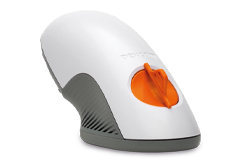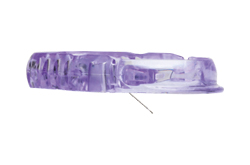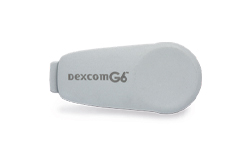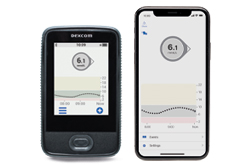Dexcom G6 is a real-time continuous glucose monitoring (rt-CGM) system that features a 10-day sensor and requires zero fingerpricks* or scanning, supporting greater freedom and flexibility for your patients ages 2 years and older.
*If your glucose alerts and readings from Dexcom G6 do not match symptoms or expectations, use a blood glucose meter to make glucose treatment decisions.

Smart devices sold separately and connected Smart device required to display readings on watch.†
Why recommend Dexcom G6?
Dexcom G6 can help empower your patients with proven accuracy1 and a suite of protective alerts, including a predictive “Urgent Low Soon” alert. Dexcom G6 can help simplify the way you treat your patients—in-person or via remote clinic appointments—to maximize their care.
Continuous Share‡
Up to 10 family and friends can receive glucose readings and alerts.‡ Widening the support network, this feature can support greater peace of mind, particularly in parents and caregivers.
Zero fingersticks* or scanning
Exceptional accuracy1 for Type 1 diabetes management, with no fingerpricks* or scanning required.
*If your glucose alerts and readings from Dexcom G6 do not match symptoms or expectations, use a blood glucose meter to make glucose treatment decisions.
Customisable alert schedules
Customisable high and low glucose alerts offer your patients the ability to set alert schedules and repeat alert functionality for discretion and flexibility.
Exceptional Accuracy 1
Urgent Low Soon Alert
The “Urgent Low Soon” Alert can warn patients in advance of a potential severe hypoglycaemic event (≤ 3.1 mmol/L) within 20 minutes and is associated with reduced hypoglycaemia, without a corresponding increase in hyperglycaemia.2
Dexcom G6 Components
Using the auto-applicator, patients or caregivers can insert the sensor and then snap in the transmitter. Then, they will be able to view glucose data from the transmitter via a patient’s selected display device.

Auto-Applicator
Simplifies the sensor insertion process with a push of a button.

Sensor
Monitors interstitial glucose levels through a small wire inserted just underneath the skin, sending a signal to the transmitter.

Transmitter
Fastened on top of the sensor; sends data wirelessly to a patient’s display device.

Display Device
Shows glucose readings and trend data on the touchscreen receiver or the patient’s compatible smart device.†
†Smart devices sold separately. To view a list of compatible smart devices, visit dexcom.com/compatibility.
*If your glucose alerts and readings from Dexcom G6 do not match symptoms or expectations, use a blood glucose meter to make diabetes treatment decisions.
† For a list of compatible smart devices, please visit www.dexcom.com/compatibility. Smart device required to display readings on watch.
‡ Internet connectivity required for data sharing. Following requires the use of the Follow App. Followers should always confirm readings on the Dexcom G6 App or Receiver before making treatment decisions.
1 Shah VN, et al. Diabetes Technol Ther. 2018;20(6):428–433.
2 Puhr S, et al. Diabetes Technol Ther 2019;21(4):155-8.